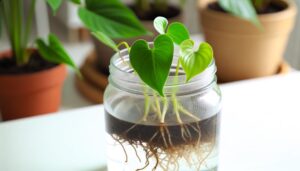How to Propagate White Knight Philodendron
Propagating a White Knight Philodendron involves precise steps for successful growth. First, gather sterilized pruning shears, well-draining potting mix, and rooting hormone.
Select a healthy stem with mature nodes and visible aerial roots. Make a 45-degree cut below the node using sterilized tools.
Plant the cutting in a pot with drainage holes filled with a mix of peat, perlite, and orchid bark. Maintain consistent moisture, indirect light, and proper humidity.
Water thoroughly when the top inch of soil is dry and use room temperature water. By following these steps carefully, one can achieve robust propagation results.
Discover additional advanced techniques.
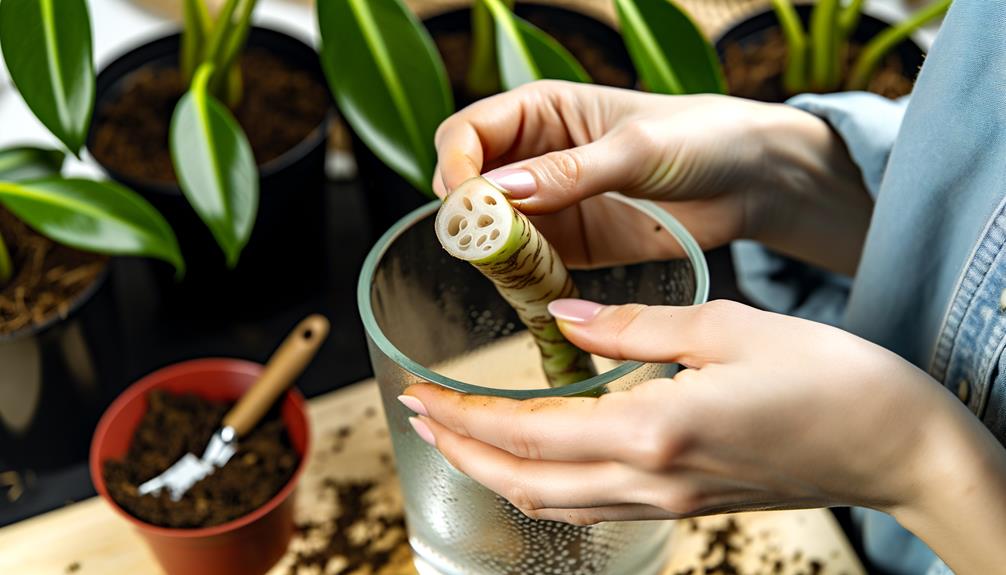
Key Takeaways
- Select a healthy stem with mature nodes and aerial roots.
- Use sterilized pruning shears to make a 45-degree cut below a node.
- Dip the cut end in rooting hormone and plant in well-draining potting mix.
- Maintain consistent moisture and provide indirect light.
- Cover with a transparent plastic bag to create a humid environment for root development.
Gather Necessary Supplies
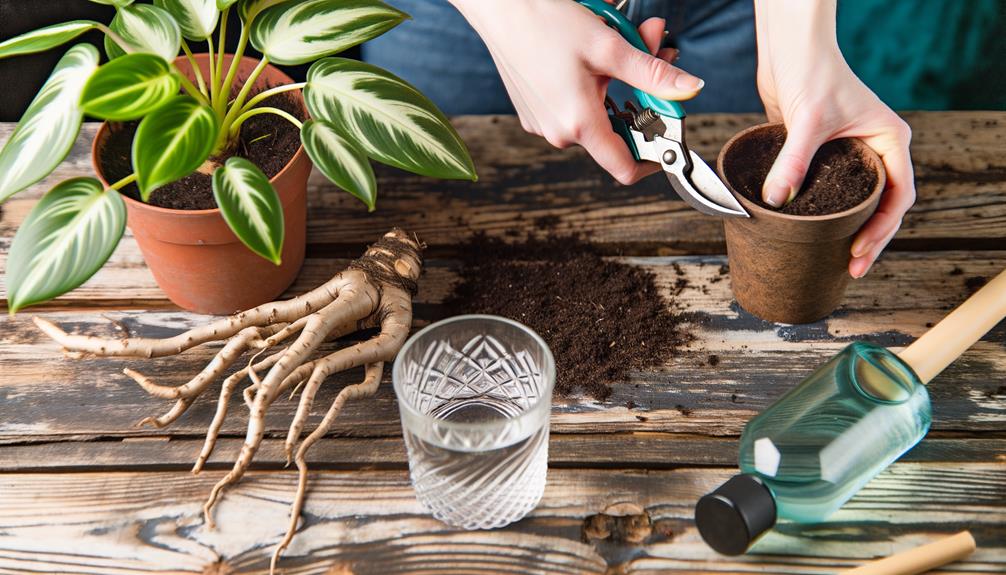
To begin propagating your White Knight Philodendron, it is crucial to gather all necessary supplies beforehand. You will need a sterilized, sharp pair of pruning shears to secure clean cuts and minimize plant trauma.
Obtain a container filled with a well-draining potting mix, ideally comprising perlite, peat moss, and orchid bark, to provide optimal aeration and moisture retention. Prepare a rooting hormone to enhance root development and reduce the risk of fungal infections.
Additionally, have a clean water source available to moisten the potting medium and rinse any plant sap from your tools. Finally, acquire transparent plastic bags or a propagation dome to create a humid microenvironment that will facilitate successful rooting. Proper preparation guarantees a higher success rate in propagation.
Choose a Healthy Stem
When selecting a stem for propagation, make sure it contains mature nodes, which are essential for successful root development.
Additionally, inspect the leaves for signs of disease or damage, as healthy foliage indicates a robust plant.
Prioritize stems exhibiting vigorous growth and vibrant coloration for best propagation outcomes.
Identify Mature Nodes
Choosing a healthy stem with mature nodes is crucial for successful propagation of the White Knight Philodendron. Nodes are critical growth points from which roots and new stems develop. Identifying mature nodes guarantees the cutting has the potential to establish itself and thrive.
To recognize mature nodes, look for the following characteristics:
- Swollen or thickened areas: Indicative of established growth points.
- Visible aerial roots: Signifying active root development.
- Healthy, firm tissue: Ensures the stem is robust and capable of supporting new growth.
- Proximity to leaves: Nodes located near leaves often have higher robustness.
- Absence of damage or disease: Healthy nodes should be free of any decay or pest infestation.
Careful selection enhances the success rate of propagation efforts.
Check Leaf Health
Ensuring the health of the leaves is a vital step in choosing an ideal stem for propagating the White Knight Philodendron. Healthy leaves indicate a robust plant, which is essential for successful propagation. Examine the leaf color, texture, and overall condition. Look for vibrant green leaves, free from yellowing or browning, which may signal nutrient deficiencies or disease. The stem should be firm, without any signs of rot or pest infestation.
| Criteria | Healthy Indicators | Unhealthy Indicators |
|---|---|---|
| Leaf Color | Lively green | Yellow or brown |
| Leaf Texture | Smooth, free of blemishes | Spotty, wrinkled, or damaged |
| Stem Condition | Firm, no signs of rot or pests | Soft, mushy, or pest-infested |
Selecting stems with these characteristics maximizes the likelihood of thriving new plants.
Make the Cutting
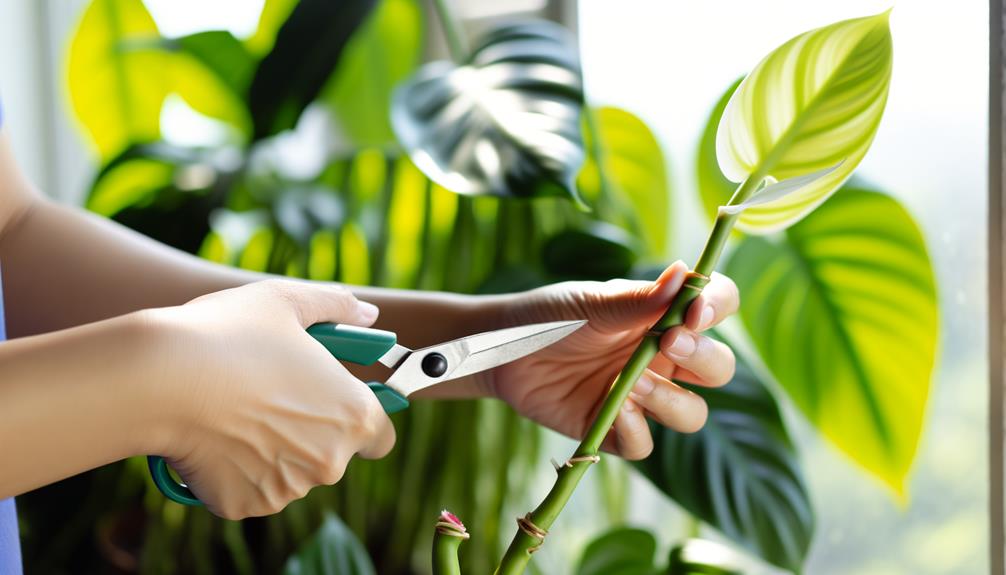
To make the cutting, use a sterilized, sharp knife or pair of pruning shears to ensure a clean and precise cut just below a node on a healthy stem. This maximizes the cutting’s chance to root effectively.
Select a stem that is vibrant and free of disease, as this will influence the success of propagation.
- Identify a node: Choose a stem section with at least one node, as this is where roots will develop.
- Use sterilized tools: Sterilization prevents the introduction of pathogens.
- Angle the cut: Make the cut at a 45-degree angle to increase surface area for rooting.
- Avoid damaging the node: Guarantee the node remains intact for peak growth.
- Select healthy stems: Ensure the mother plant is robust to support successful propagation.
Prepare the Cutting
To prepare the cutting for propagation, begin by selecting a healthy stem with at least one node and a few leaves.
Verify your cutting tools are sterilized to prevent infections.
Make precise cuts just below the node to enhance root development.
Select Healthy Stem
A healthy stem should be selected for propagation, characterized by strong growth, vivid coloration, and at least one node where new roots can develop. This ensures a higher likelihood of successful rooting and subsequent plant health.
Key characteristics to look for include:
- Strong Growth: Stems should be thick and firm, indicating vigor.
- Vivid Coloration: Healthy green hues suggest best chlorophyll levels.
- Presence of a Node: Nodes are essential for root development.
- Absence of Disease: Avoid stems with discoloration, spots, or soft patches.
- Ideal Length: Cuttings should be 4-6 inches long for balanced growth.
Clean Cutting Tools
Making sure the cutting tools are thoroughly cleaned and sterilized is essential to prevent the introduction of pathogens that could jeopardize the health of the White Knight Philodendron. Begin by washing the tools with warm, soapy water to remove any soil or plant residues. After rinsing, immerse the blades in a 70% isopropyl alcohol solution or a diluted bleach solution (1 part bleach to 9 parts water) for at least 5 minutes.
This process effectively eliminates bacteria, fungi, and viruses. Allow the tools to air dry on a clean surface. Regular maintenance of cutting instruments, including sharpening, reduces the likelihood of tissue damage and guarantees clean incisions. Properly sanitized tools are a crucial step in successful plant propagation.
Make Precise Cuts
When propagating the White Knight Philodendron, making precise cuts just below a node is crucial for successful rooting. This practice guarantees that the cutting has sufficient cambium tissue to develop roots. Utilizing sterilized, sharp pruning shears is essential. Aim for a clean, diagonal cut to maximize the surface area for rooting.
Key points to bear in mind:
- Node Identification: Ensure the cut is made just below a node, where root growth is most viable.
- Angle of Cut: A diagonal cut increases rooting surface area.
- Number of Nodes: Include at least one node and one leaf on the cutting for optimal growth.
- Stem Condition: Choose healthy, disease-free stems.
- Timing: Conduct cuttings during the plant’s active growing season for best results.
This meticulous approach promotes robust propagation.
Plant the Cutting
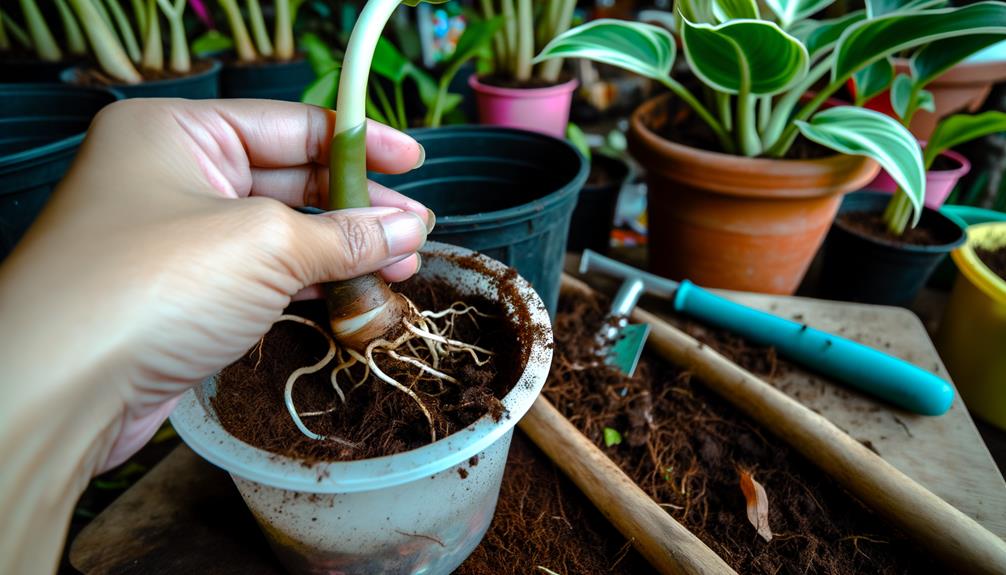
Choose a well-draining potting mix to promote ideal root growth for the White Knight Philodendron cutting. A mixture containing peat, perlite, and orchid bark offers an excellent balance of aeration and moisture retention.
Fill a small pot with the potting mix, ensuring it has drainage holes to prevent waterlogging. Insert the cutting into the soil, ensuring the node is submerged, as this is where roots will develop. Press the soil gently around the stem to secure it in place.
Water the soil lightly to settle it around the cutting, but avoid overwatering. Place the pot in a warm, humid environment with indirect light. This setup provides the necessary conditions for the cutting to establish roots and begin thriving.
Care for New Growth
To foster healthy development in the new growth of your White Knight Philodendron, maintain consistent moisture in the soil while ensuring it remains well-drained. This balance is vital to prevent root rot and promote vigorous growth.
Light:
Provide bright, indirect sunlight to support photosynthesis without causing leaf burn.
Humidity:
Keep humidity levels between 60-80% to mimic the plant’s native tropical environment.
Temperature:
Maintain a stable temperature range between 65-80°F (18-27°C) to avoid stress.
Fertilization:
Apply a balanced, water-soluble fertilizer every 4-6 weeks during the growing season.
Pruning:
Remove any yellowing or dead leaves to redirect energy to new growth and maintain plant health.
Conclusion
To sum up, propagating the White Knight Philodendron involves a meticulous process akin to a gardener’s symphony.
Ensuring the right supplies, selecting a robust stem, making precise cuttings, and providing ideal care are the harmonizing notes in this endeavor.
By adhering to these steps, one can cultivate new growth successfully, contributing to the plant’s thriving lineage.
The result is a flourishing philodendron that mirrors the gardener’s skillful orchestration of nature’s rhythms.






